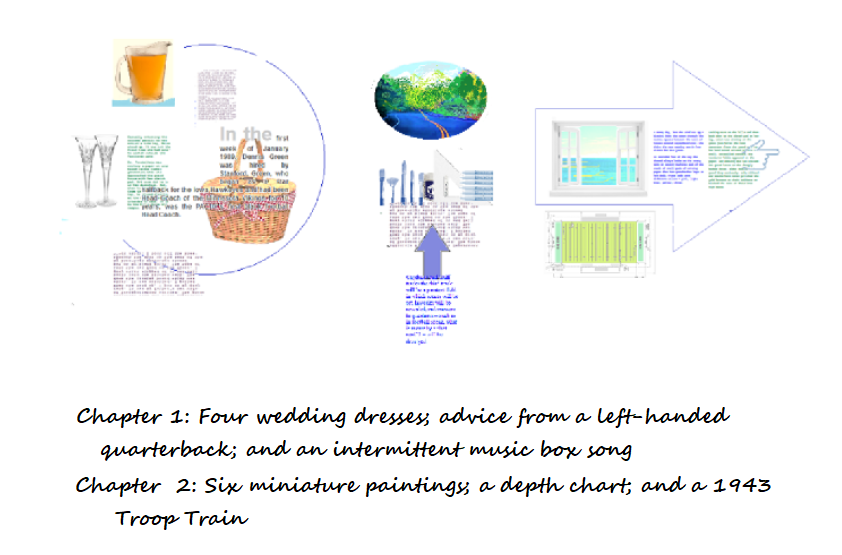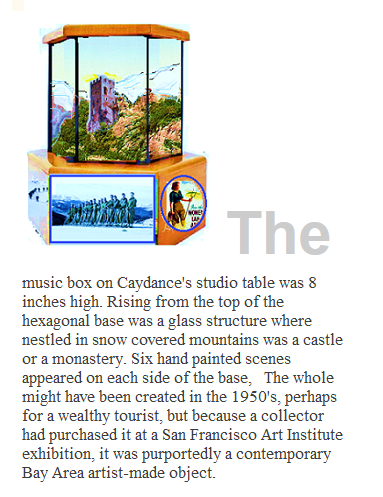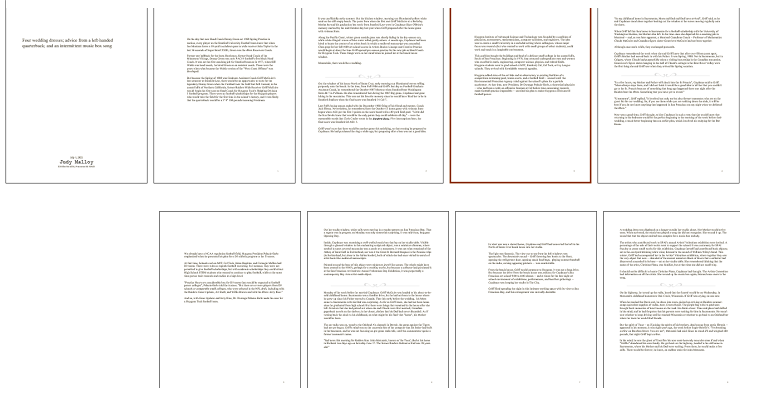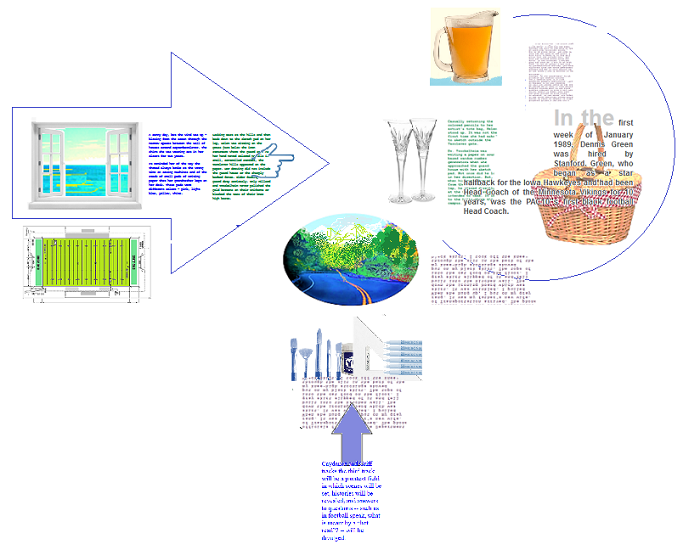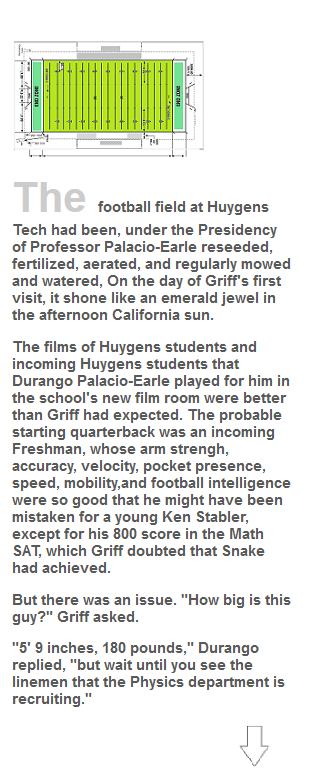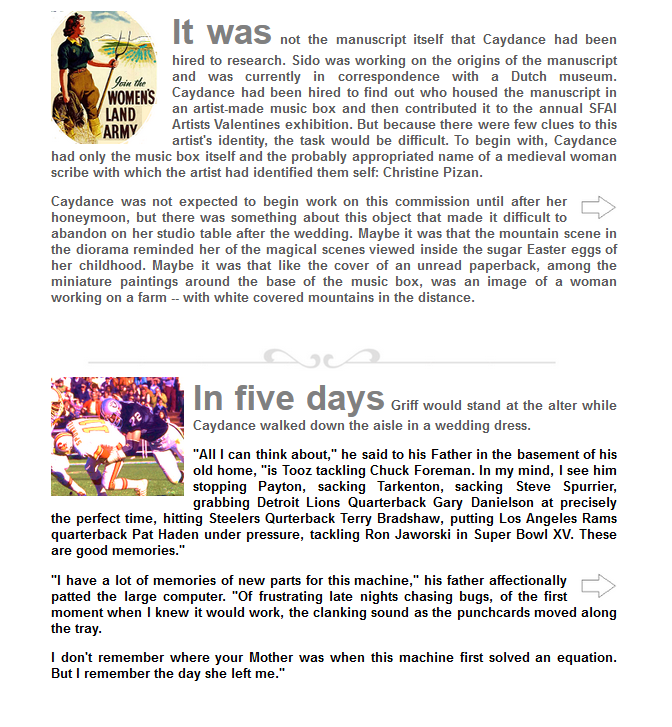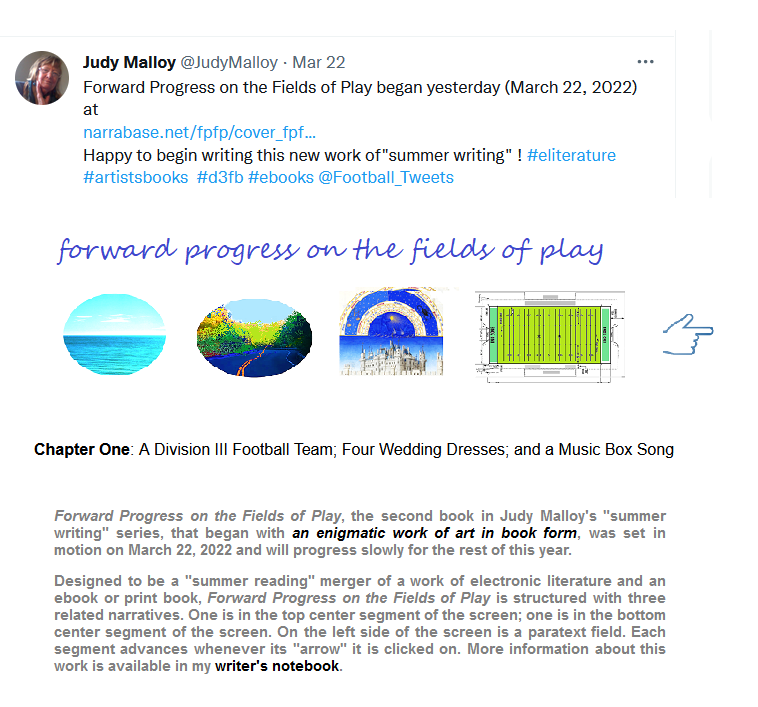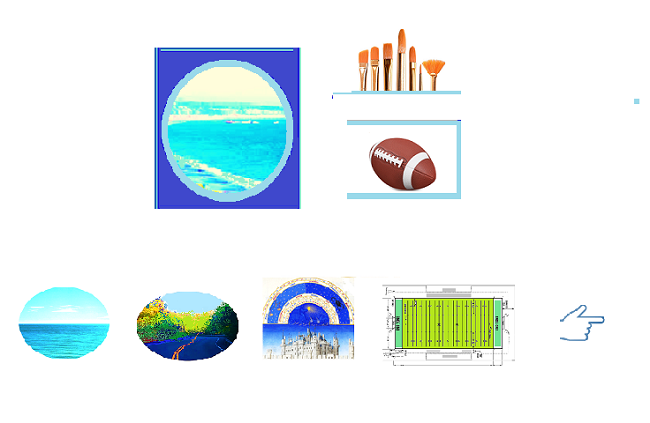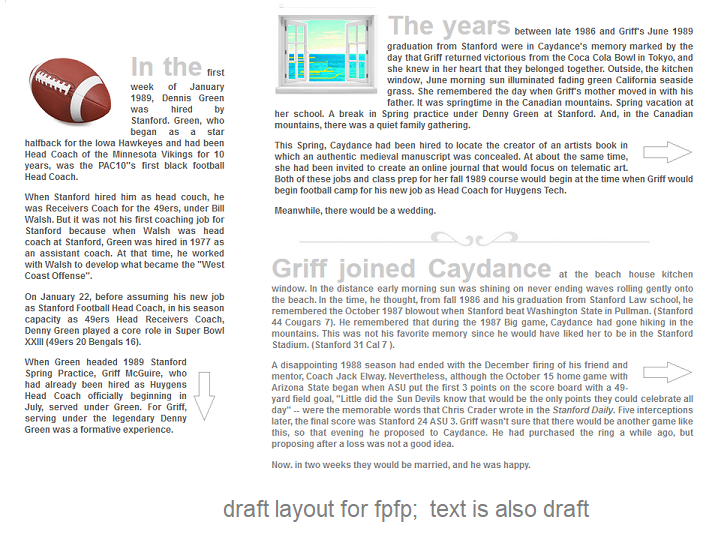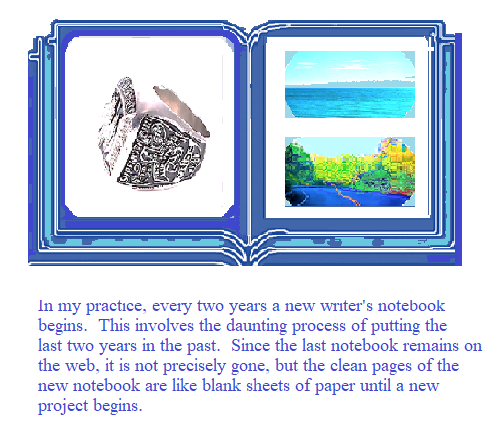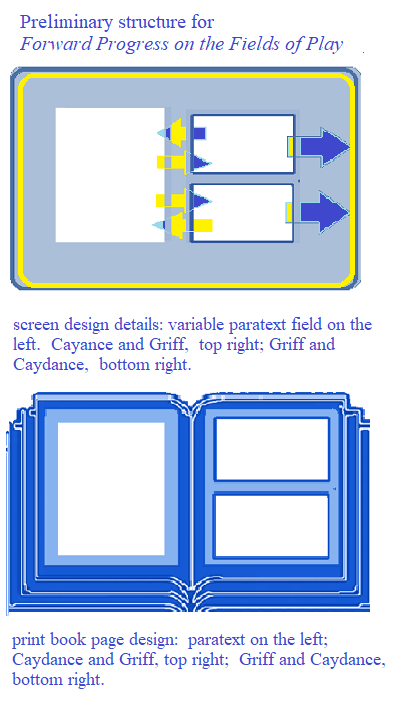|
Judy Malloy: A writer's notebook is not a final paper but rather reflects the development of a work or series of works. In the informal, recursive, yet productive practice of creating notebooks online, ideas and sources are developed and slowly emerge. With plans for Forward Progress on the Fields of Play (FPFP) , this 2022-2024 notebook began in February 2022. With notes on the progress of FPFP, this notebook continued in 2023 and ended in April, 2024.
April 7, 2024 T oday I close this writer's notebook that spanned the conception and composition of Forward Progress on the Fields of Play. The last entry in this notebook might have been written a month ago, but in addition to enjoyable time spent traversing the extraordinary Midterms created by the students in my School of the Art Institute of Chicago Women Artists in Cyberspace class, March 2024 was the time of preliminary editing of Forward Progress on the Field of Play. Looking critically at my own work is for me the opposite of being immersed in the energy of writing. And, the details involved in the editing process are not conducive to notebook writing. By creating an authoring system that would easily generate a print book manuscript -- and writing in that structure -- I had facilitated that part of the process. However, the differences between reading electronic literature and reading print literature were constantly on my mind, as in the print version I eliminated the icon images. These image-based icons functioned to hold reader interest in a book length work situated in the vast World Wide Web. Also, they heralded the content of each 3-part section (Paratext, Caydance, Griff). Additionally, they were a part of reader control and interaction -- the ability to decide on where to wander that distinguishes electronic literature. That said, I was also aware that uninterrupted (not image driven) words by themselves facilitate the powerful connection that occurs for readers, who seek immersion in completely author-controlled world models created in print literature. This aspect of print literature became more evident during COVID reading whan -- having seen and re-seen many films, some audiences turned to books. And, it was this experience that inspired my decision that print versions would be the final form of the trilogy for which FPFP is the middle work. It should however be noted that different narratives inspire different story-telling forms. For instance, the coming and going of memories in its name was Penelope would not work well in print, and the unpredicably of the narrator's life would not work as well in print as it does in Arriving Simultaneously. With this in mind, hypertextual interactivity and/or generative hypertext will return to my work when the FPFP trilogy is completed. Meanwhile: when mysterious installation art plans are discovered in a deserted San Francisco studio South of Market, Caydance investigates; an ice rink and students with skates appear on the Huygens Tech campus; what Will did on his summer vacation is revealed; and Griff ponders unexpected issues in the Fall 1990 football depth chart. My next notebook -- projected to begin in May 2024 -- will cover the conception and creation of an as yet unnamed sequel to FPFP. February 1, 2024 A draft of the print version of Forward Progress on the Fields of Play is in the completion stage. Now, following the writing process of this mystery of procedural deduction, which -- although at its core is in the realm of art history -- is structured with football games and complex playbooks, I embark on the task of placing Forward Progress on the Fields of Play in the hands of a book publisher. Below is a draft summary. The year is 1989. In Caydance O'Brien McGuire's San Francisco studio is a box on which a series of miniature scenes are painted. Inside this relatively contemporary object, a curator discovered a portable medieval book of hours. Caydance, who teaches an art school class on artist-created books, has been hired by its discoverer -- New Orleans Cajun-born black Curator Sidonie Frazier -- to decipher the meaning of the images on the music box and in the process reveal the provenance of what is now known as the "Music Box Book of Hours". Along the way -- beginning in the French Court of Anne of Britanny and with a subtext of the early history of the French Canadian Colony Acadia (now Nova Scotia) -- the Music Box Book of Hours is lost in the Italian Mountains during an Ill-fated French invasion; found by a goatherd; sequestered for centuries because of an image of Bathsheba bathing; sold for food during World War II; and won in a card Game by Pete Lafitte, an American soldier stationed in Italy. Meanwhile, when Caydance's new husband, Griff McGuire, former Raiders Wide Receiver, recent Stanford Law Graduate and Graduate Assistant Coach for Stanford football, begins his first year as Division3 Head Football Coach for Huygens Tech, a series of football games pervade the narrative. As Caydance and Griff negotiate the differences in their lives, a French children's song emerges from the Music Box Book of Hours; surprising Acadian flora and fauna, including a moose, appear in the medieval manuscript; and its now apparent value attracts a gang of manuscript thieves. When Sido Frazier and the family of Pete LaFitte meet at the Canadian Vermont border, the mutual heritage of Northern and Southern dispersed Acadian families emerges amidst manuscript thief incursions. January 16-17, 2024 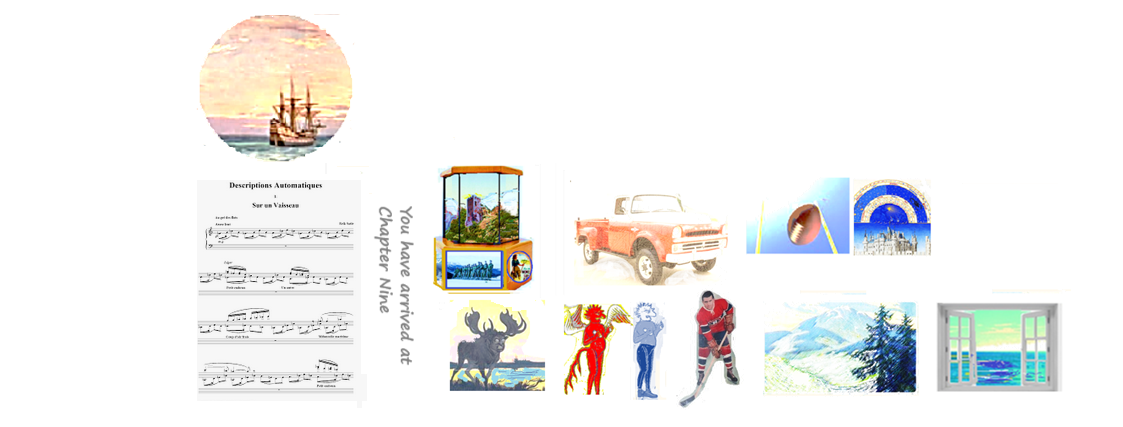
T he electronic literature version of Forward Progress on the Fields of Play (FPFP) , has been completed, except for the editing of the final chapter, Chapter 9. I'm working on this and also on compiling the print version. For Forward Progress on the Fields of Play, print is my vision for the final work. This is not usual in my work, but -- often unseen by the reader -- authoring systems do underlie certain works of print literature. Sonnets are, for instance, structured systems. "Traditionally, the sonnet is a fourteen-line poem written in iambic pentameter, employing one of several rhyme schemes, and adhering to a tightly structured thematic organization," the Academy of Poets observes. In the visual arts, when photorealistic painting is done by technically projecting a photograph onto a gridded canvas, and each grid is painted (often with an airbrush), the result is an image in which resonant details combine to create a recognizable whole with contemporary life resonance -- such as the cars in Robert Bechtle's work; such as how details of televised sports intersperse with everyday life in Forward Progress on the Fields of Play. Looking towards a future of wider literary acceptance of electronic literature, Lloyd Wise's ARTFORUM observations about photorealism come to mind: "...By now, the once-provocative innovations of Photorealism are so embedded in contemporary art that they barely register at all. Take a photographic image, paint it faithfully from a projected slide: This method is ubiquitous, deployed in a wide range of ways to a variety of effects. So it is surprising to be reminded just how offensive this practice once was..." (Lloyd Wise, review of Robert Bechtle at the Gladstone Gallery, 2014). Because there are aspects of electronic literature that cannot be easily replicated in print -- such as interactivity, animation, animated polyphony, and aleatoric composition – it is important that electronic literature become more central in literary creative practice. Contingently, algorithmically-structured creative writing by writers and artists also has the potential to create vigorous print literature. With this in mind, my plan is to seek a publisher for the print version of Forward Progress on the Fields of Play. Whether or not the digital version remains up will depend on negotiation with the print publisher. It should also be noted that while the images in the electronic literature version are necessary to hold reader attention in a virtual environment (that has different reader expectations of length), in a print version, elimination of images has the potential to contribute to the immersion that print writing elicits with writing alone. Thus, it is my plan to eliminate the images in the print version of FPFP. I've always wanted to code an aleatoric database of images only, so yes there will be a use for the images in Forward Progress on the Fields of Play. Not just one image will be generated at a time in this visual electronic manuscript. Instead, each play will sort the images in different narrative flow-chart patterns, and segments of the code might also be included in the output. November 20-22, 2023
As the longer than usual timeframe between entries in this notebook comes to a close, in my Fall class in Social Media Narratives, my students are writing proposals for Final Projects, and at home, I have finished writing Forward Progress on the Fields of Play Chapter Eight..
Chapter Eight, the next to last chapter of Forward Progress on the Fields of Play, emerged slowly, lexia by lexia. This way of writing, which -- partially from the experimental artists books at the core of my early creative practice -- has been a part of my work for many years. Writing is done in units of text, and each unit is designed to stand by itself or be combined with other blocks of text -- whether sequentially, hypertextually, at random, or polysequentially. The authoring system for a football play is initially polysequential to the coaches and the players, but, although certain elements stand out for the viewer, if all goes well, the team moves sequentially down the field.
After editing is done on Chapter 8, The final chapter of FPFP will begin in December. September 4-6, 2023 At this point in the creation of a narrative, certain fictional people, places and things have become real in the mind of the writer. Huygens Tech is fictional. Really? The Music Box Book of Hours is fictional. Really? That maps of the Canadian Atlantic coast existed in 1453 is possible. However, the map of the Grand Banks of Newfoundland that a sailor/illuminator included in the circa 1453 Music Box Book of Hours is fictional.
The first well-known map that includes the Canadian Atlantic coast was created by Juan de la Cosa, a sailor whose birthplace was arguably Cantabria on the coast of Spain. Perhaps -- as was Brouage-born Champlain -- from a family of sailors, Juan de la Cosa was the owner of Columbus’ flagship, the Santa María, and he sailed with Columbus on numerous voyages. On his Map of the World, which includes Newfoundland, a colophon written in Spanish translates as "Juan de la Cosa made this in the port of Santa Maria in the year 1500". But because in another early 16th century map that includes the Candian Atlantic coast, the 1502 date of the Cantino Planisphere is the date that it was smuggled from Portugal to Italy by Alberto Cantino, an agent for the Duke of Ferrara, the actual date of its creation by a Portuguese chart maker could be earlier than the map included in the fictional Music Box Book of Hours.
When I moved from Ipswich, Massachusetts to Sunnyvale, California, I made the map pictured here. Created on ricepaper with ink, it can be removed from its container and unfolded. It opens to map size (larger and more detailed than pictured).
August 7-8, 2023 A midst presenting a paper on Data and Process in Information-Centered Creative Practice via zoom at the 2023 Electronic Literature Conference in July in Coimbra, Portugal; and the pleasure of working with students in my School of the Art Institute of Chicago summer course on The Electronic Manuscript; and slow progress rehabbing from a stress fracture in my knee, Chapter Seven of of Forward Progress on the Fields of Play was completed. As usual, some editing will need to be done on Chapter Seven, and then in late August, I'll begin writing Chapter Eight. The work will conclude with Chapter Nine, although there may also be a short Epilogue.
While I continued to urge students to keep artist's notebooks, June and July entries in my own notebook were not written. Along the undocumented way, things that should be noted have been replaced by other things that should be noted. Currently on my mind is that the paratext field -- which I included in every three-lexia set of Forward Progress on the Fields of Play -- has contributed greatly to this work as a whole. There is a seldom mentioned back and forth structural contingency in contemporary print literature and electronic literature. For instance, the always riveting rapid shifts between the action of different characters in Mick Herron's Slough House series and the way this occurs via reader traversal in electronic literature; for instance the "reveal" that occurs in print fiction -- last seen by this reader in John Banville's disturbing conclusion to The Lock-Up -- and the way "reveals" occur as a result of reader traversal in certain works of electronic literature.
In practice, every time I reach the end of a 3-lexia set and begin again with a paratext, there is a moment of dismay when I realize that a forthcoming detail-laden paratext will be difficult to write. And yet -- when, for instance, the reveal of the identity of the illustrator of the fictional Music Box Book of Hours brought up questions of the length of the 15th century shipboard journey to the Grand Banks of Newfoundland; of the interaction between scribes and illustrators in an atelier in the Château de Plessis-lèz-Tours; and of the role of Anne of Brittany in the commission of the Music Box Book of Hours -- I am always surprised at how well detail works in the paratext field of Forward Progress on the Fields of Play. May 24, 2023 A Spring of working with involved students in my Women Artists in Cyberspace class at the School of the Art Institute of Chicago was rewarding. As information becomes inescapable online, creative practice in information art is of increasing interest, and I'm revisiting information art in a paper for the Electronic literature Organization Conference in July. And so, while urging art students to keep notebooks, I did not write an April entry in my own notebook.
Notes: ____The more that -- into the three-branch structure I created -- I write lexias that reveal the narrative, the more that the act of writing has become a rhythmic writing pleasure. In preparation for my summer class SAIC class, The Electronic Manuscript, It has also been of interest to explore how words, images, and borders were structured in 15th Century French Books of Hours. ___In early May, a memorable experience was the reading of Nicolas Denys: The Description and Natural History of the Coasts of North America. Originally published in 1672 as Description geographique et historique des costes de l'Amerique septentrionale: Avec l'histoire naturelle du païs, with an extraordinary array of animals, trees, rivers, and harbors, it describes the landscape of Arcadia from 1632 through 1670. An English translation was made in 1908 by William Ganong.
___The Acadian heritage that threads through the narrative of Forward Progress on the Fields of Play was significant in Northern Vermont. At Middlebury College where I went to school, legendary Right Wing French Canadian Phil Latreille scored a record 250 goals, and in my sophomore year, I lived in the top tower room of Le Chateau, a French-speaking dorm (Below Château of Amboise in the graphic above). Although in ___The Music Box Book of Hours was probably created in the studio of French Court Painter Jean Bourdichon, during the reign of Anne of Brittany, either when she was the wife of Charles VIII from 1491-to 1498 or when she was married to his successor, Louis XII. It is not my intention to rewrite history in a work of fiction. Nevertheless -- as evidenced in the fictional Music Box Book of Hours by images such as the Moose and the map of the Grand Banks of Newfoundland -- pre-documented exploration of Acadia could have occurred. Indeed, in the manuscript collection of the Morgan Library, enormous lobsters -- such as described by Nicolas Denys ("There are some of which the shell of the front claw holds a pint or more") occur, primarily in mid to late 15th century French manuscripts. The one I used as an icon in Chapter Six of FPFP, is from Book of Hours, France, Paris, ca. 1485-1490 MS M.231 fol. 6r. . Among other examples in the Morgan collection are the gigantic Lobster (France, Loire, ca. 1475 MS G.1 I fol.) and the blue lobster in Book of Hours France, Provence, ca. 1440-1450 MS M.358 fol. 6v. ___Portions of the French childrens song -- 'Maman, les p'tits bateaux qui vont sur l'eau" -- that the music box plays in FPFP -- emerge in Erik Satie's "Sur un vaisseau". When I began writing Forward Progress on the Fields of Play , it took a long time to find this song and decide that it was exactly what I sought. Note that the abbreviation of "petits" as "p'tits" is common in Acadian French. March 26-27, 2023 C hapter 6 of Forward Progress on the Fields of Play has begun! At this point, it is a pleasure to write a story when the plot and characters themselves begin to drive the narrative. Additionally, creating graphic flow charts is helpful in clarifying the flow of the story.
In the previous notebook entry, concern was expressed about my story-telling device of narrating a football game from a game film. Emerging from a difficult preliminary editing of Chapter 5, the experience of watching football is still on my mind.
Although watching an entire football game by playing a game film is obviously not as rich an experience as actually being at the game, many of us experience football games through television. Ultimately, the players themselves and the plays are why there are certain games and plays that we watch over and over. But how games on television are framed by broadcasting teams including color commentators (the memory of John Madden superimposing drawings on video stills lingers) is also a part of why football games have cultural resonance. This cultural resonance has become clearer as more and more historic games appear on YouTube. Game film on the other hand is generally created for team training. A fictional game film of a fictional game is a removed experience. Thus, as I predicted in my last notebook entry, much editing of Chapter 5 was required. However, a focus on the moment when backup quarterback Damian Jefferson Tyler runs onto the field now provides -- after editing -- a satisfactory climax. And the addition of Sally Highpine as Huygens football videographer has subtly changed the nature of this game film experience. A few years ago, a student in my Women Artists in Cyberspace class at SAIC created a series of drawings of videographer Deng Lu, a Chinese woman cinematographer, who carries a Steadicam weighing 60 kilograms every day. (for details, page down in the central introduction here ). It was Deng Lu whom I had in mind when the fictional Sally Highpine became the team videographer. Forward Progress on the Fields of Play is envisioned as enfolding in ten chapters. In Chapters 6 and 7, two events that actually occurred will intrude into the narrative. Included in Chapter 6 will be the Revealing Conversations exhibition at the Richmond Art Center from October 3 to November 19, 1989. Curated by Zlata Baum, Revealing Conversations was pivotal in the development of digital art in the Bay Area. Memorable was the room that included my its name was Penelope, Abbe Don's We Make Memories, , and Sonya Rapoport's Shoe Field. Also memorable was the room with Lynn Hershman's Lorna and Sara Roberts' Early Programming. I look forward to writing about this exhibition; it is an opportunity to recall many memories and much information. For instance, in an interview that Anna Couey and I did on Arts Wire, Sara describes Early Programming in this way: "...In it the visitor sits down at a kitchen table with a computer 'mom', (named MARGO), and is recruited, if not forced, into the role of a child. Scenes on a monitor, shot from a child's point of view, introduce topics of conversation like cleaning up your room, practcing the piano for half an hour, eating the rest of your dinner, etc. MARGO says the things mom say, like 'Are those my good scissors?!' You have a menu of replies ranging from goody two-shoes obsequiousness to outright rebellion. Your reply effects her overall mood, and thus what she says back to you...)" But the most difficult event (slated for chapter 7) is the Loma Prieta earthquake, which began about 20 minutes before the 3rd game of the 1989 World Series between the Oakland A's and the San Francisco Giants.
February 20, 2023 The Spring semester has begun. This week in my School of the Art Institute of Chicago Women Artists in Cyberspace class, we are exploring contemporary women artists who work in virtual environments. Meanwhile in a guided study class (which I advise), an MFA student will create an exhibition informed by a series of readings that she herself selected. Often, when a semester begins, I am so immersed in the class materials -- and the work and the ideas of art students -- that my writing slows down. Hopefully, about now, all these things including my own writing are in sync and working well.
A challenge in the writing of Chapter 5 of Forward Progress on the Fields of Play
It was my intention to use this device to tell this game
But, although in each version the text would be exactly the same,
January 19, 2023 A ccompanied by a few notes in this notebook, Chapter 5 of Forward Progress on the Fields of Play has begun. ___1. Forward Progress on the Fields of Play (FPFP) takes place in 1989. As anyone who is writing about 1989, where FPFP is set (or other years before the mid-1990s), is aware, the issue of why fictional characters cannot communicate with cell phones arises. In 1989, although there were a few bulky models available, mobile phones were not in general usage. In 1989, some characters will have access to email; most will not. For instance, the Chair of the Huygens Tech Math Department expects his students to communicate with him via email. Although Griff McGuire, the Huygens Tech Head Football Coach, might have had an email account when he was a graduate student at Stanford, he does not use email to communicate with his players. However, in this year of increasingly hybrid communication, art school professor Caydance O'Brien can and does exchange email with Art Com Director, Carl Loeffler. The first email I ever received was from Carl in the Spring of 1986 -- via Art Com Electronic Network (ACEN) on The WELL. I still remember the thrill of this first instant communication flashing on the screen of my Apple II -- almost immediately after the forever memorable sound of the modem announced of a new era in communications. Contingently, The story in FPFP -- of what happened at the ACEN September 1989 Ars Electronica-based exhibition when Linz-based Ars Electronica was held at the beginning of the Fall of the Berlin Wall -- is true. It is told in more depth in Judy Malloy, "Art Com Electronic Network On The Well: A Conversation With Fred Truck And Anna Couey " in Social Media Archeology and Poetics Cambridge, MA: MIT Press, 2016. ___2. Although in most of my work, main characters are completely fictional, once in a while they are inspired by people who were a part of my life. An example is my college friend Edwina, whose spirit inspired the fictional character of Edelira. Edwina was much more social than I was -- a situation she often tried to remedy when from her home in Miami she visited me in the Bay Area. When I began writing the romance between art collector Sido and A's Coliseum groundskeeper, Tyrone, I was remembering the time Edwina and I went together to a Bay Area sports bar and spent a pleasant evening talking with two Major League Stadium groundskeepers. ___3. Although the historical background is relatively accurate, the contents of the Music Box Manuscript -- that will continue to slowly emerge -- are entirely fictional. Contingently, the parallel between warring European city states in the 15th Century and the time of the NFL playoffs was not meant to be forced. It is only an echo that once in a while resounds throughout the 3-part structure of the elit version of FPFP. The detail of an image of Anne of Brittany, that graces the second paratext of Chapter Five of FPFP, is from Les Grandes Heures d'Anne de Bretagne attributed to Jean Bourdichon and held by the Bibliotheque Nationale de France.
___4.
Once in a while, there are elements of magic realism, for instance in Professor Bond's cars:
___5.
And once in a while, as the author of this work of initially elit-structured work of "summer writing", not only do I observe with wonder the complexity inherent in every play in a football playbook, but also I wonder why Dukes from another country populate so many contemporary romcoms, when as NFL playoffs are in progress, our heroes are so much more interesting.
January 2, 2023 A s the New Year begins, crits in my Social Media Narratives class are completed, and as always it was a pleasure to traverse the works my students have created, that this year range from Twitter-based documentation of a series of played in real life Dungeons and Dragons games, to the use of Chinese social media posts to explore public reaction to Zero-COVID policies in China. Among many others, also of importance are Instagram-hosted graphic narratives that confront post COVID depression and contingently a video that -- exploring the impact of Animal Crossing in the COVID era -- is a seamless combination of Animal Crossing-based performance and real life performance of the same situations. As soon as possible, I'll add the students in this class to the documentation of past courses in Social Media Narratives. As I head now to my Spring course on Women Artists in Cyberspace I'm planning to make the game I designed for the class -- Women Space Cyberspace -- public and will be contacting the women whose work is included in case they want to make changes or suggest improvements. Meanwhile Chapter 4 of Forward Progress on the Fields of Play is completed and in the next couple of weeks before Chapter 5 begins, I'll be editing chapter 4 with an eye not only to rocky transitions within this chapter but also how this chapter works within the whole. Uploading a lexia every day or so is a way of working that began years ago with Uncle Roger. Nowadays, when suddenly it is apparent that near final draft writing has escaped from my notebook. this process lets me see how the whole works before it is finalized. My writing generally uses what we now call lexias in electronic literature but in my work were originally based on full text database records that are complete by themselves. My vision was that writing in this way enabled the writer (and eventually the reader) to in various ways traverse what was the equivalent of a deck of cards in such a way that however they were manipulated, the whole had meaning. The authoring system for fpfp allows the lexias as a whole to eventually be read sequentially in a print work. However, because each lexia is written separately, it is necessary to revisit the whole and make edits that will enable the print version to flow more smoothly -- while the interactive reading that the elit version empowers continues to work.
Meanwhile, in fpfp, two chartered buses are on their way the Sacramento Valley. On bus no 1, Griff is going over the depth chart. There are still issues with the Defense, but the Offense is looking good. However, since from a writer's point of view, four Offensive Linemen:
Huygens Tech Offense Coming soon: the Defense Depth Chart, and the return of Yuri to Caydance's artists books class December3-4, 2022
C hapter 4 of Forward Progress on the Fields of Play begins with soldiers and manuscript illuminators at Chateau d'Amboise in the 15th Century French Loire Valley; begins with a Fluxus book probably created in the French Dordogne Valley in the 20th century, begins in San Francisco beside the blue patterned tile-lined fish pond in the courtyard of the art school where Caydance teaches. It is 1989: meanwhile at Huygens Tech, the IC Chips are preparing to play the Sac Valley Harriers, and the arrival of a 3rd Wide Receiver has filled Griff's life with the joys of spread options. Will Abigail join Harvey at a Motel in the Sacramento Valley? Will writer anxiety about the names of the players delay the completion of the Huygens Tech depth chart? In this Google era, it seems necessary to check names for characters in works of fiction; this is why naming characters has become difficult. Harvey was not my first choice for the name (it is not his real name) that Abigail calls Peggy's father, but because the story dictates that that name should not be on the Pittsburgh Steelers roster, there were difficulties. I tried at least 20 first names -- Tyson, Rudy, Mel, Brian, Corwin. Kirk, Dante, Wayne, Keith, Chase, Ted, and so forth -- but every one of them had at some time played or coached for the Steelers. Finally, even though there was a Harvey, who played for the Steelers, Harvey was the name I chose. One solution to the problem -- of giving fictional characters names that do not appear on Facebook -- is to provide middle names, as in this section of the Huygens Tech Depth Chart:
WR DeJuan Marlon Achebe, Cupertino, CA
Football has changed radically since my Dad, Ike Powers, played for Dartmouth in the early 1930s, and my Grandfather, "Cappy" Lillard played for Dartmouth in the early 1900's and was subsequently Dartmouth Football Head Coach. Nevertheless -- for the atmosphere of sports talk that has forever pervaded my life -- it is time to credit my Dad, who, before the war intervened, played hockey for the now defunct but influential Boston Olympics, and my Grandfather (the first English professor to coach Andover football), with whom I lived while my Dad was teaching anti-aircraft weapons, invading Normandy, and subsequently wounded in the Battle of the Bulge.
November 10-11, 2022 T he question arose -- as I prepared the beginning of a print manuscript of Forward Progress on the Fields of Play by lifting the words from the three part structure and removing most of the icons -- was how does the computer-mediated structure and inclusion of visual elements change the writing and reading process? Usually, I have not considered creating print versions of my work. For much of what I wrote that would not be workable. Arriving Simultaneously on Multiple Far-Flung Systems is a good example of a narrative that is not workable in print. The interface -- in which the reader clicks on images to produce randomly-generated words -- would not work in print. Not only is "click" not available in print, but also because when text appears in response to an image click, it is generated randomly (technically pseudo-randomly), it will be different every time. My vision for this work was to create an aleatoric narrative that was effective for a reader for whom narrative was important. For this reason, the central character choice -- a women working with technology in an age of constantly changing computer-mediated environments -- was workable, although it should be noted that the equal roles of writing and code were important in the authoring system for this work. But with the series of works that begins with an enigmatic work of art in book form and is followed by the work in progress Forward Progress on the Fields of Play, I wanted to develop authoring systems that would work equally well in a print version and an electronic literature version. Contingently, print itself could be considered a technology. My sense is that for many readers of fiction immersion is important -- but that immersion is achieved differently in print literature and electronic literature. To radically simplify this, reader activation and control are important in reader immersion in computer-mediated works, but immersion in print literature relies on authorial flow of the words that keeps the reader in the author's fictional world model, and immersion in print narrative precludes the very actions that immerse the reader in computer mediated environments. Much more could be said about this.... Nevertheless, as I have written in the past: print literature and e-literature are parallel art forms where ideally writers in each medium will understand each other's vision and, as between poetry and fiction, it will be possible to move with ease between the two mediums. With music box-simulating composition, in an enigmatic work of art in book form, the authoring system and words moved without too much difficulty between electronic literature and print (at least when I created an unpublished print version). But when I took the music box analogy somewhat further by making the music box the host for a medieval manuscript, and at the same time increased the complexity of the authoring system, some issues arose. That said, as always, work on the whole has been interesting and enjoyable. I have finished Chapter 3 of Forward Progress on the Fields of Play and am about to begin Chapter 4.
October 9, 2022
A
fter much content editing of Chapter Two: In addition to the editing of Chapter Two, Chapter One has been extensively edited and now serves as a Prologue. At times, in the writing process, there are sections of a narrative that work well for the writer but are too long, considering their place in the narrative as a whole. Because discarding writing is seldom something that a writer wants to do, it was not until I observed this phenomenon in recent reading that I knew I had to compress the Wedding of Caydance and Griff -- and had the courage to do so. In the process I removed quite a few lexias from what was Chapter One and is now The Prologue. This was not easy. However -- as memories that occur as the narrative proceeds -- my plan is to re-enter much of the currently no longer visible writing. Now, the Prologue introduces Chapter Two in a way that is satisfactory for my vision, and some parts that are no longer seen will return in narrative places where a diversion is desired. After the struggle that occurred in the reduction process, I am happy that from a treasure of lost writing, some memories will slowly emerge in future writing. Chapter Three of Forward Progress on the Fields of Play. will begin in a week or so! September 2-3, 2022
Of primary interest in the recent writing of Chapter Two of Forward Progress on the Fields of Play is the use of the paratext field to introduce a World War II backstory. The backstory can be and is introduced anywhere in contemporary writing, but what the paratext field does in my authoring software for fpfp is to create a place where backstories are both told and retrievable in a place of not only writer access but also reader access. It is not a question in my mind of whether (in the case of my work) this is better or worse. Indeed I have been writing three column narratives differently for years (for example The Yellow Bowl). The paratext field is simply just a different way of doing this that is working for this writer's vision. Two notes regarding Chapter two of Forward Progress on the Fields of Play. 1. The image of a Land Girl that appears in this chapter is a British Women’s Land Army Recruitment poster (1938), designed by Clive Uptton. Among his other work as an artist, Uptton was a painter and an illustrator. From 1940-42. Uptton was a political cartoonist. 2. Fred Neuberger enlisted in the US Army on July 27, 1943. It was his 18th birthday. Unlike many of the skiers who joined the 10th Mountain Division, Fred, the son of a textile worker in Pittsburg, Massachusetts, was from a working class background. But he had been skiing the steep, challenging Thunderbolt trail at Mt Greylock since he was 15 years old. With a high school degree and letters of recommendation from the Mount Greylock Ski Club, Fred was sent where he wanted to go: to Camp Hale, the 10th Mountain Division Training Camp at over 9,000 in the Colorado Rockies. Wounded and captured by the Germans in Italy during the dangerous skier-led reconnaissance missions before the taking of Riva Ridge, Fred was imprisoned in the notorious Stalag7A Nazi prison -- until Stalag7A was liberated by the 14th Armored Division, at that time under the command of General Pattons' Third Army (under whom/which my Dad also served until he was wounded at the Battle of the Bulge). With a bronze star for heroism in combat and a purple heart, after the War, Fred Neuberger was invited to study at Middlebury College in Vermont, where he skied for the Middlebury’s championship Alpine Ski team, coached by the legendary “Bobo” Sheehan. In addition to becoming Coach of the Middlebury Women's Ski team in the 1950's and 60's, Fred was the United States Women's Ski coach in 1962.
10th Army Lt Pete Lafitte, who (spoiler alert) in a card game wins the medieval French manuscript that appears in fpfp, is entirely fictional, and is not based on the very different life of Fred Neuberger. But Fred's story and others that I knew from my family and from skiing lore were important in the desire to include the 10th Mountain Division in the story that I am writing now.
Over the years I've read, seen, and heard much about the World War II Mountain Troops, but the book on hand at the moment is A source for what members of the 10th Mountain Division did after the war -- a source that includes Fred Neuberger -- is David M. Leach, "The Impact of the Tenth Mountain Division on the Development of a Modern Ski Industry in Colorado and Vermont: 1930-1965", Thesis Submitted in Partial Fulfillment of the Requirements for the Degree of Bachelor of Arts in the Department of History, Middlebury College, April 2005.
August 17, 2022
Chapter two of Forward Progress on the Fields of Play has begun. Given that I have been teaching a six week intensive course on The Electronic Manuscript -- and that much research needs to be done for fpfp -- the writing is progressing slowly, Nevertheless, working within this hybrid structure continues to be a pleasure. The Electronic Manuscript is not a well defined genre. But it has been fascinating to see what the awesome art students in this class are creating -- from an extensive character and place development wiki-based fantasy with interactive fiction potential; to a collection of identity-based animated doll rooms; to stop motion animation documentation of quarantine lives; to a twine based work composed of aleatoric excerpts from summer reading. As I wrote in an introduction to this class: "In this time of changing approaches to reading and writing, situating the written word, images, moving images, and sound in a medieval manuscript context, electronic manuscripts respond to the aesthetic context of the 'framed' computer screen, as well as to the heightened potential of digital interactive practice." Some of the works artists are working on or have completed in this class could also be considered electronic literature but in this School of the Art Institute of Chicago class, the category electronic manuscript elicits other approaches, such as neon text in a sculptural situation; an information art-grounded approach to the history of sugar; and maps that explore territory in ways that challenge, expand, expose perception of places -- for instance a black student's map of Benton Harbor Township. The intensive three class a week schedule has been a fast ride/experience for all or us, but in the process a flow of creative energy has been generated. Meanwhile, in Forward Progress on the Fields of Play, it is 1943. Lieutenant Pete Lafitte is on his way to Camp Hale, and I've watched the movie Troop Train more times than necessary.
July 8-9, 2022
The writing of Forward Progress on the Fields of Play (FPFP) has progressed more slowly than expected, primarily because the new summer course on The Electronic Manuscript -- that I'll soon be teaching at The School of the Art Institute of Chicago -- required a lot of thinking and structuring to develop. The Electronic Manuscript is a three credit course that that will begin next week and complete in six weeks. I'm looking forward to the work my students will create in this intense summer Art&Tech Adventure! Meanwhile, on the verge of beginning to write Chapter Two of FPFP, a few things come to mind. 1. Because the screen is too crowded, the paratext field does not work well in the electronic literature version of FPFP. Happily, when I turned Chapter One into a print manuscript (see above for the page layout), the print version was/is precisely what I envisioned. I anticipate that although some readers will skip the paratext field on first reading; in search of narrative detail, some will eventually return to read this field. This attribute of electronic literature -- where reading is not necessarily an expected sequential process -- has not proved easy to transfer to print book authoring. However, because in the FPFP print layout, the paratext is always in the same place, it will be possible for the reader to without difficulty return and follow the paratext trail. Noting that this affordance might not transfer as easily to an ebook edition of a print work, at some point, I will probably experiment with using separate screens for the online paratext and lexia components. 2. In a work of fiction, what is real and what is not becomes more relevant for readers when contemporary writers insert real people into works of fiction. And, it should be noted that although perhaps it will be obvious to the reader that Huygens Tech does not exist in the real world, in my mind, Huygens Tech is now as real as the memorable annual San Francisco Art Institute Valentines Day Exhibition. The FPFP central idea of an altered music box came to mind because one year, I painted a thrift shop-purchased music box for that exhibition (I don't remember which year). I also altered the scene viewed thru small windows in the music box and painted text around the circumference. I think I have a slide of this work somewhere, but I no longer have a record of who bought it -- nor do I have a record of who bought another work that I made for this exhibition in another year. That work was an electro-mechanical artists book in which dense penciled text written on paper cards flipped when buttons were pushed. I do not have a slide of this work. However, in another year of the SFAI Valentines exhibition, Rene di Rosa bought a photograph and documentation for my Free Values performance. About 20 years later, this work was included in the exhibition "Looking at You Looking at Me", di Rosa Center for Contemporary Art, Napa, California, October 29, 2011 - February 11, 2012. It should also be noted that most of the art works described in FPFP are/were real, including Bill Viola's Sanctuary, which I saw at Capp Street in 1989. 3. The slow but intriguing way in which the cover icon for FPFP emerges, may not be a final cover, but it currently reflects the development of this work. June 3, 202
T he end of May brought final projects for my School of the Art Institute of Chicago "Women Artists in Cyberspace class"; inspired by the work of women artists, the final projects in this class were extraordinary. It will take a while before the page for this class is completed and approved by each student, but the documentation for this class in 2020 and 2021 is available at here. And this week intensive prep in The Electronic Manuscript. begins for my summer course The hybrid 2022 Electronic Literature Organization Conference was held in Como Italy from May 30- June 1. It would have been wonderful to be at Lake Como, but the zoom component worked seamlessly with the in person component, and it was a pleasure to give a talk on "Narrative in the Contemporary Social Media Environment" and to host a workshop section on Pre-Web Authoring Systems. Meanwhile, Chapter One of Forward Progress on the Fields of Play has been completed. In this chapter, when Caydance's father hosts a rehearsal dinner at a sports bar, a surprising Best Man arrives; on the sides of the O'Brien Company car, Caydance's students airbrush a color-laden hyperreal mural of seductive football equipment and suggestive art supplies; and against a background of continuing wakes for John Matuszak, the wedding of Caydance and Griff takes place in a chapel in San Francisco. Meanwhile in the paratext, the details of Griff's new job are revealed, and Claude admits that it was not velocity to jump calculations that long ago attracted him to a young French Canadian figure skater. See the examples below for a sample paratext and two sample lexias.
The second chapter of Forward Progress on the Fields of Play will begin as soon as possible. Because I'd like to keep within some semblance of the football season, since that is a comfortable situation for the writing, Chapter 2 may not actually appear online until the beginning of August, after Griff has taken the notoriously difficult California Bar Exam and a few weeks before preseason training at Huygens Tech begins. As the Huygens Tech football team gets ready to take the field in September, Griff will plunge into the difficulties that lie ahead. He will have one student assistant coach, funded for academic reasons because D3 football teams cannot give Football scholarships. Otherwise, besides Griff's job as Head Coach, there are three faculty members who will serve as volunteer assistant coaches: Physics Professor Durango Palacio-Earle as Defense Coach and his colleague, a Professor from the University of Hawaii as Offensive Line coach. An Irish engineer, who played soccer for Republic of Ireland, will be special Teams Coach. Rumor is that his younger brother will be transferring to Huysmans as a sophomore. The narrative will unfold, as did an enigmatic work of art in book form, primarily from Caydance's point of view. Caydance herself will soon be prepping for her fall class in artists books. Additionally, she will be working as a consultant for Sido, the black curator who hired her to find the artist who created the music box in which a medieval manuscript was hidden, And, she has accepted a job writing about electronic art for Northern California Edition of MicroCurrents, a newspaper about California computer. This part of the narrative will be based on my own work as a Contributing Writer for MicroTimes , but will need to be a fictional publication since I did not begin writing for MicroTimes until 1992)
April 8-11, 2022
Amidst dark gloomy days, rain, more rain, cold and some bleak problems with my multi-fractured leg, once again in an annual springtime miracle, yellow flowers have appeared on the trail. On March 22, 2022, I started posting Forward Progress on the Fields of Play. Like an old car on a cold day, first chapters move with more precision when the engine has warmed up. I'm just beginning to reach stride, so it is likely that Chapter One will not conclude until the end of April. A few notes as this work begins: ___The paratext field will work very well in a print book if displayed on a left hand page, while the Caydance and Griff lexias appear on the right hand page. In my vision, the paratext field is a solution to the need for background information in the second book of a series. But online, the page design is not as elegant as is the screen design for an enigmatic work of art in book form. Online, of course, it would not be difficult to only display the Caydance and Griff screens but to give the reader an interface choice to call up the paratext field. But this "summer writing" series is designed to shift easily to print publication, so I want to write with this clearly in mind.
___Chapter One, which will conclude with their June 24, 1989 wedding, begins a week before Caydance and Griff are married. Thus -- when researching the whereabouts of potential wedding guests -- I googled John Matuszak, it was with dismay that I realized that his death on June 17, 1989, was only a week before the fictional wedding of Caydance O'Brien and Griff McGuire. When fiction is set in a real time period, it is my practice to incorporate real events of the time. For instance, all the football games and most of the art exhibitions in enigmatic actually took place in reality at the time that that they occurred in enigmatic. Thus, the impact on Griff McGuire of his former teammate's sudden death at age 38 now weaves through the events of Chapter One of Forward Progress on the Fields of Play. For example, because Griff's informal bachelor party, the usual drinking cruise though the Cactus room, Clancys, Uppys (and wherever bar, whose name has faded through the years), was semi-planned to take place on Wednesday (when a regular gathering would generally happen anyhow), the Wednesday before Griff's wedding would not be an informal Bachelor party, it would be a wake for the man they called "the Tooz". On the same day, in Oak Creek Wisconsin, there was a funeral. ___But it wasn't until Griff heard of Matuszak’s death while listening to A's radio on his way to Sacramento that I realized that not only would the Loma Prieta earthquake occur during Huygens' first season as a D3 football team, but also that Griff's beach house and the Huygens campus were located near the epicenter of the earthquake. The details of what happens as a work progress are in my case often written on the fly. But when Chapter Seven of fpfp is begun this October, there will no avoiding the events of October 17, 1989, the day that a 6.9 earthquake struck right before the opening of the third game of the 1989 World Series between the American League champions, the Oakland Athletics, and the National League champions, the San Francisco Giants. Fans from both sides of the Bay were in their seats in Candlestick Park at 5:04 PM when the earthquake struck.
March 12, 2022 It is at this point in the start of a new work that a notebook is helpful not only in developing ideas but also -- as is necessary when coding is combined with research and words -- in focusing on where to begin. Sometimes it seems that there is so much work that needs to be done before the writing of Forward Progress on the Fields of Play begins that suddenly I need to go for a walk or study the availability of snacks. Notes: ___More research needs to be done than I anticipated. This week it has involved re-reading An introduction to Manuscript Studies (Raymond Clemens and Timothy Graham, Cornell Univerty Press,(2007); becoming familiar with what is needed create a Division III football team (This has been surprisingly interesting); and because Griff will be attending football games to observe other coaches in action, choosing real fall 1989 games to include in the narrative -- for instance the September 23, 1989 Stanford versus the Oregon Ducks game when Stanford overgame a 17 point deficit (Stanford 18 Ducks 17 Coach Denny Green); and the tense November 4, 1989 San Jose State versus Fresno State game. (Fresno State 31 San Jose State 30 Coach Jim Sweeney)
___ Create a working cover. This is done. A directory has been created, and the working cover was uploaded; later, there will be a more dynamic cover. Note that in print writing situations, the cover is a part of the final process of publication, and it is contractually usually created in-house by the publisher. But when a work is initially created on the fly online, a cover marks where a work begins in the now vast Internet. ___Create a contents page. A draft contents page has been created and uploaded. It will provide an index for the reader who follows the narrative as it slowly develops, and, for me, there is a feeling of satisfaction as each new chapter is added to the contents. This is helpful in the drive to keep on schedule, so that the work is finished in a reasonable time. ___Create a working structure for the online version. This has been done. A pleasant surprise is that the paratext field I envisioned is extraordinarily useful. It allows narrative development without overloading the narrative-bearing lexias with detail. Additionally, it will elegantly transfer to a structured print book. Meanwhile, midterm project proposals have arrived in my SAIC ATS Women Artists in Cyberspace class. And I look forward to seeing how students will create their midterm projects!
February 26, 2022
On January 1, 2022, I finished the writing for an enigmatic work of art in book form. This year --2022 -- was planned to now be a year of generative poetry. but I was immersed in the lives of Caydance Skye O'Brien and Griff McGuire to the point that the month and a half of not working on the narrative that began in enigmatic has been -- with the exception of class prep and teaching -- cheerless. Therefore, with the working title Forward Progress on the Fields of Play (FPFP) the further adventures of Caydance and Griff will begin sometime in March 2022. The following precis sets the stage, although it will likely evolve when the writing begins: In the spring of 1989, an artist book collector hires Caydance to research the provenance of what appears to be an authentic medieval manuscript housed in a contemporary book object. Meanwhile, an eminent astrophysicist -- who years ago played as a "walk on" for a University football team and is now the incoming president of an elite Oakland Hills-based university for computer scientists. engineers, and physicists -- offers Griff, who will soon graduate from Stanford Law School, a challenging coaching job. Will Griff accept this position, or will he accept a coaching position with a Division1 Central Valley university and repeat his father's mistake with his mother? Memories in a paratext field will reveal information, such as after which game did Griff propose to Caydance? And, is the rumor that Mackey Alarie escaped from prison true?
In the version which I will be creating online, more interactivity will be possible. But how the paratext field will be controlled by the reader is a not yet answered question... This 2022 writer's notebook follows my 2020-January 2021 notebook |


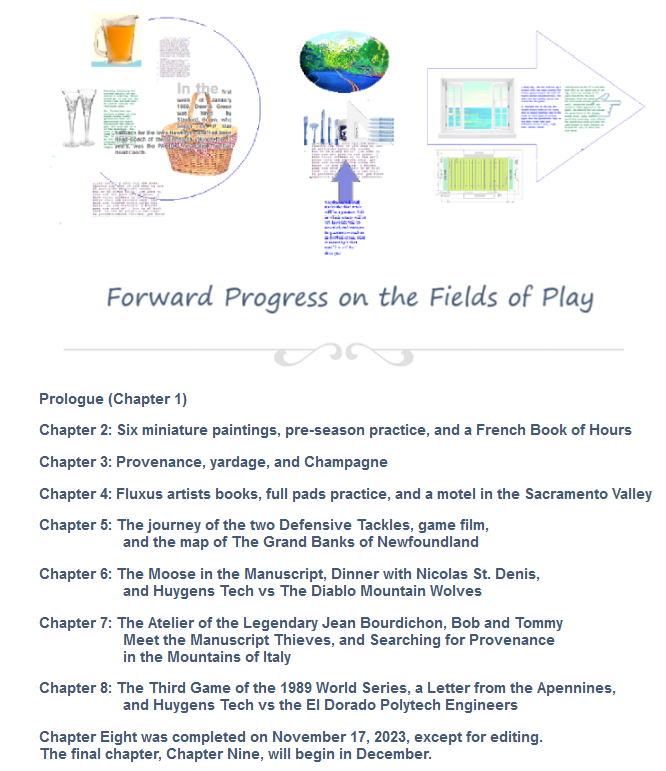
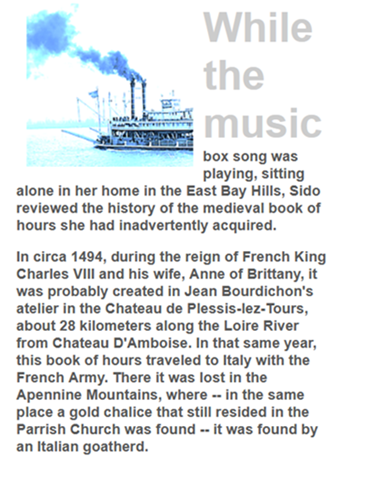 Also in this timeframe, the sound version of
Also in this timeframe, the sound version of 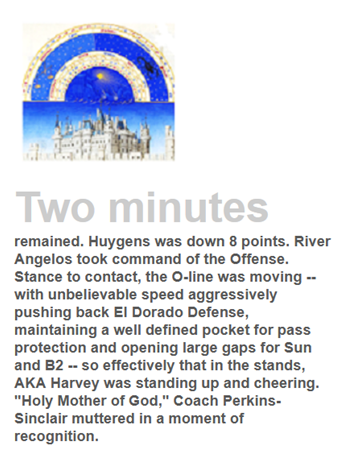 In FPFP, although the online version is polysequential, the print version will be sequential, in keeping with this primary affordance of print book authoring. At this point, the polysequential structure will be apparent only in the probability that -- although not evident to many readers -- the repeated rhythm of Paratext/Caydance lexia/Griff lexia will underly the whole. Not surprisingly, since this was my intention, the translation from the online version to the print version is working well.
In FPFP, although the online version is polysequential, the print version will be sequential, in keeping with this primary affordance of print book authoring. At this point, the polysequential structure will be apparent only in the probability that -- although not evident to many readers -- the repeated rhythm of Paratext/Caydance lexia/Griff lexia will underly the whole. Not surprisingly, since this was my intention, the translation from the online version to the print version is working well.
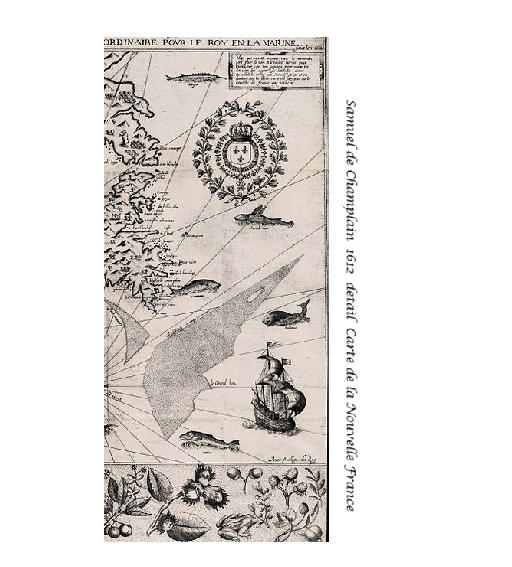 Both my early interest in artists' maps and the FPFP Chapter Seven revelation that the fictional maker of the Music Box Book of Hours was a sailor, who also worked as an artist, were in part inspired by the information-dense beauty of French artist and sailor/explorer Samuel de Champlain's 1612 Carte de la Nouvelle France.
Both my early interest in artists' maps and the FPFP Chapter Seven revelation that the fictional maker of the Music Box Book of Hours was a sailor, who also worked as an artist, were in part inspired by the information-dense beauty of French artist and sailor/explorer Samuel de Champlain's 1612 Carte de la Nouvelle France.
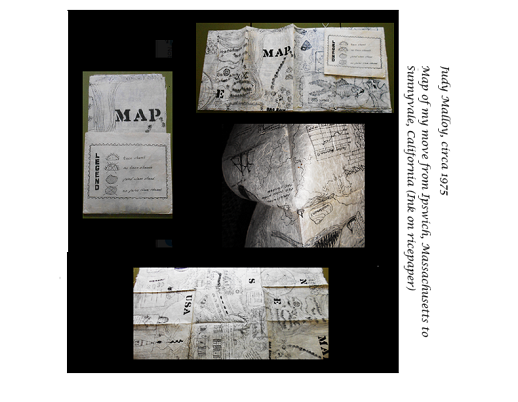 My own early interest in narrative maps was in the maps themselves, rather than in their nautical importance.
My own early interest in narrative maps was in the maps themselves, rather than in their nautical importance.
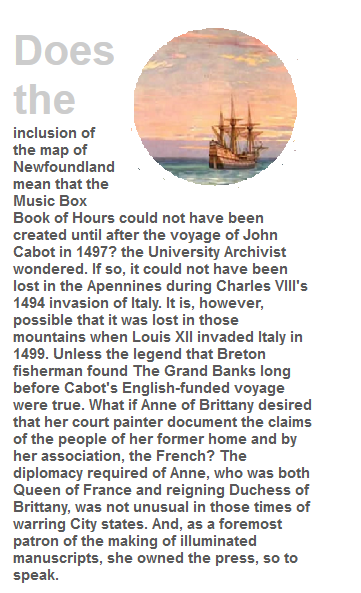 Contingently, use of a non-convential paratext field in FPFP invites detail, as well as serving as the site of "reveals" -- some never seen by the protagonists. Maybe a poet's decidedly structural inclusion of the paratext field will not be welcome in all fiction reader/writer circles. However, electronic literature draws also on music composition, where structure-dictated composition is more likely.
Contingently, use of a non-convential paratext field in FPFP invites detail, as well as serving as the site of "reveals" -- some never seen by the protagonists. Maybe a poet's decidedly structural inclusion of the paratext field will not be welcome in all fiction reader/writer circles. However, electronic literature draws also on music composition, where structure-dictated composition is more likely.
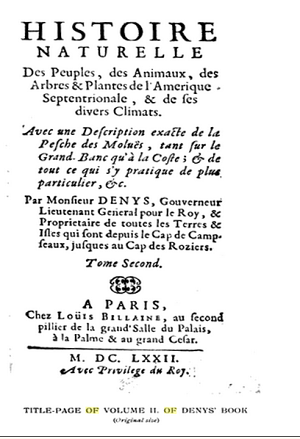 Nevertheless, on May 21, I finished writing Chapter Six of
Nevertheless, on May 21, I finished writing Chapter Six of 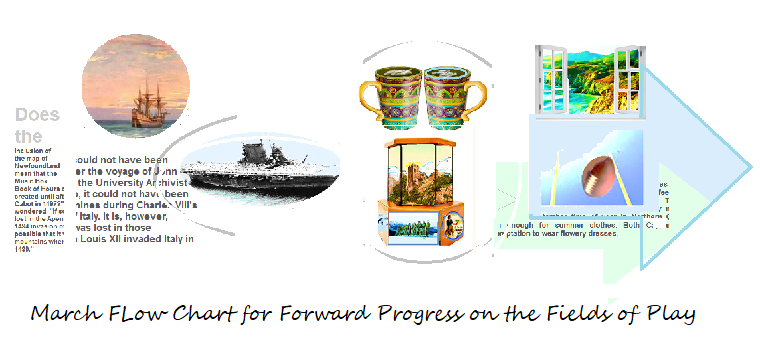
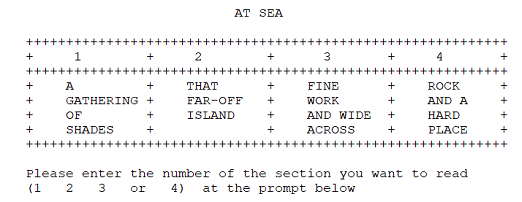 March 30, 2023. Also important in Chapter 5 of Forward Progress on the Fields of Play is the return of American soldiers from World War II. As may have been the case with other very young children, in 1944 or 1945 I was not told that my Father was wounded, and I do not know how he got home. How this impacted my life is alluded to in its name was Penelope.
March 30, 2023. Also important in Chapter 5 of Forward Progress on the Fields of Play is the return of American soldiers from World War II. As may have been the case with other very young children, in 1944 or 1945 I was not told that my Father was wounded, and I do not know how he got home. How this impacted my life is alluded to in its name was Penelope.
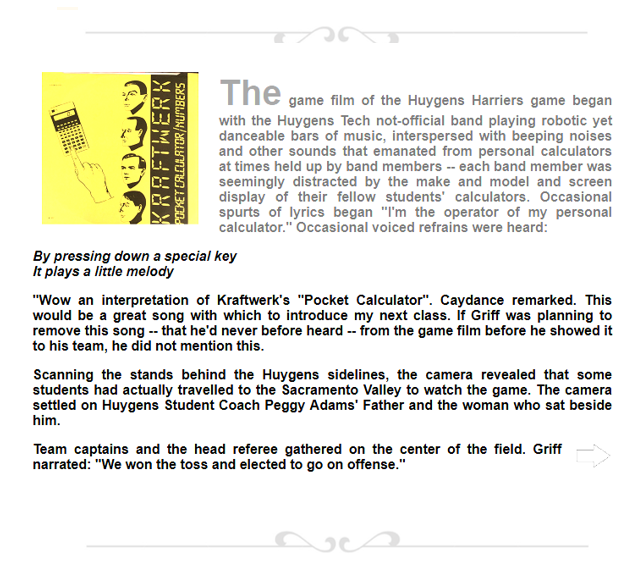
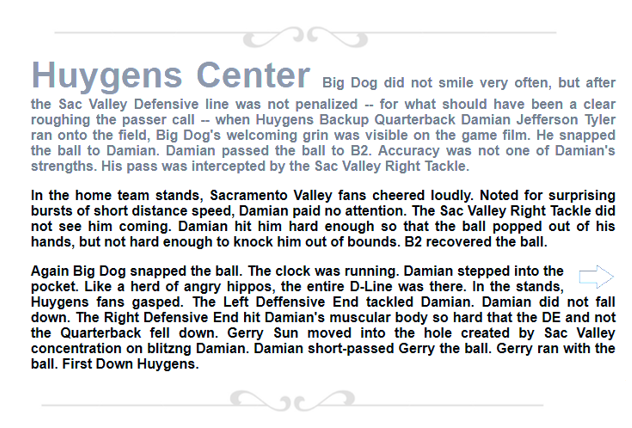
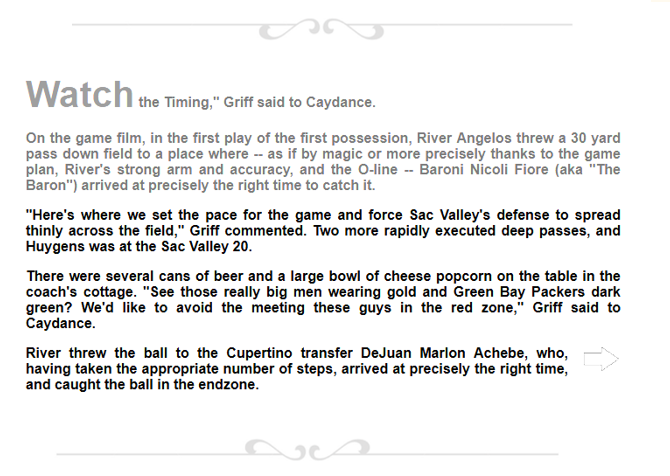
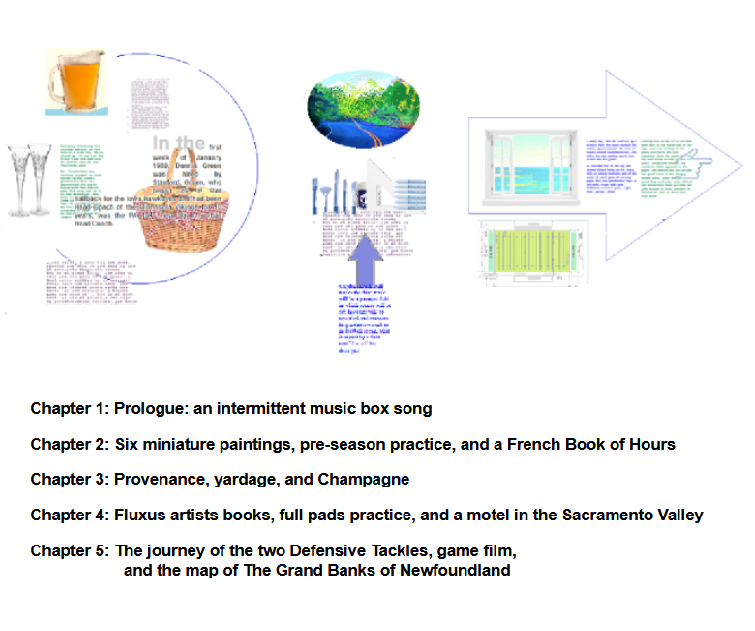
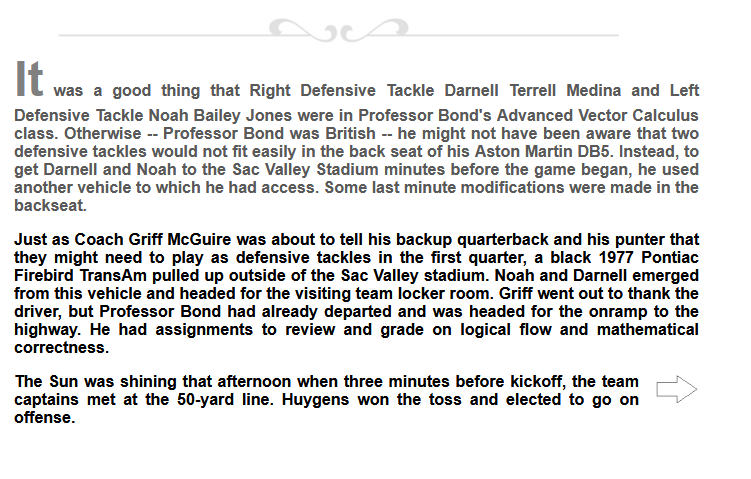
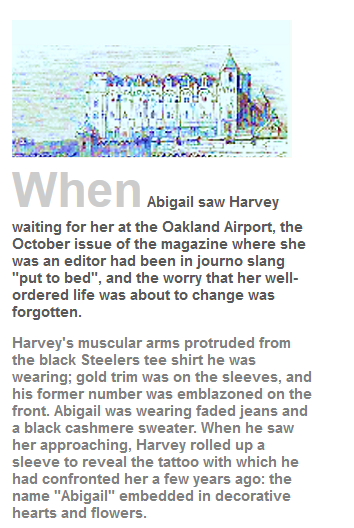
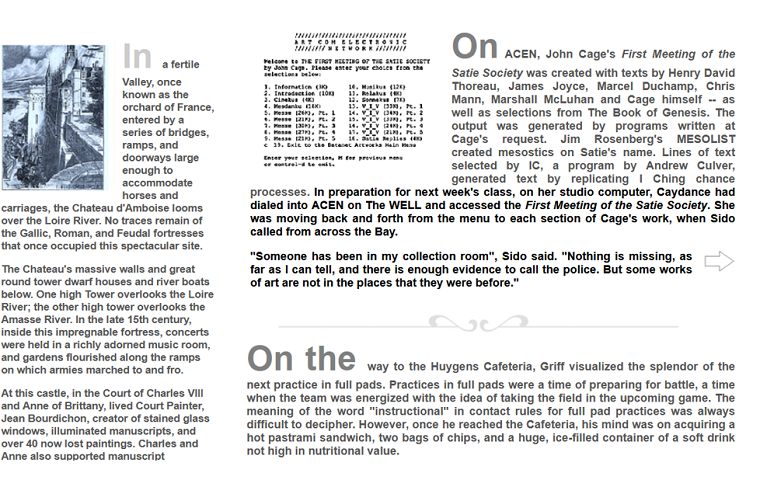
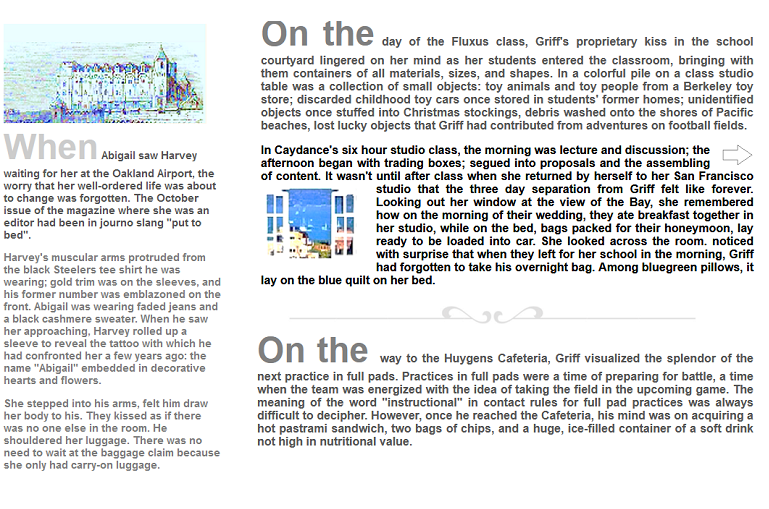
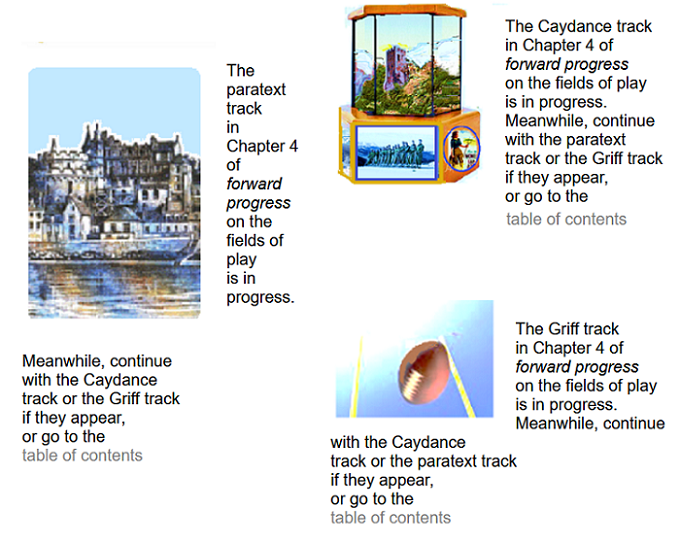
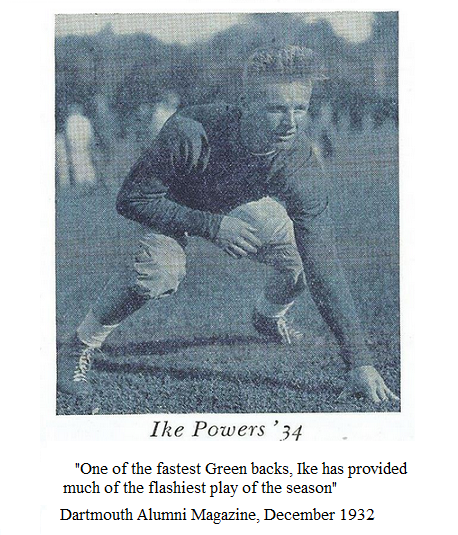 "'There is no escape from men who talk football', Griff remarked as he turned on the radio."
"'There is no escape from men who talk football', Griff remarked as he turned on the radio."
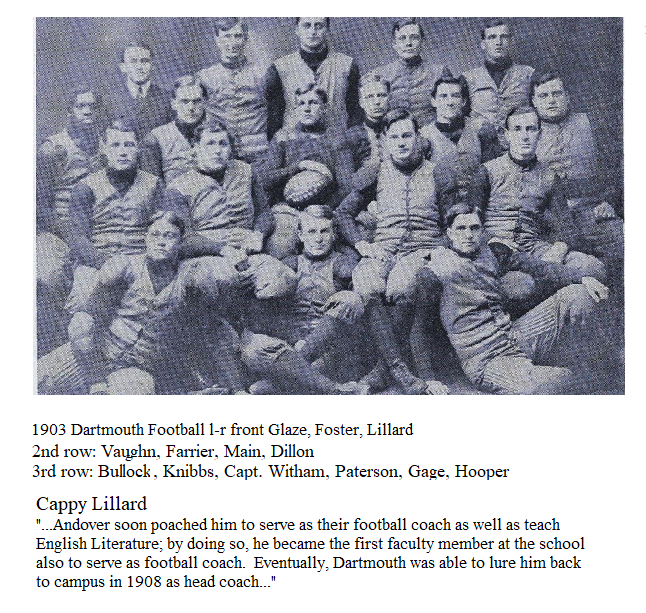
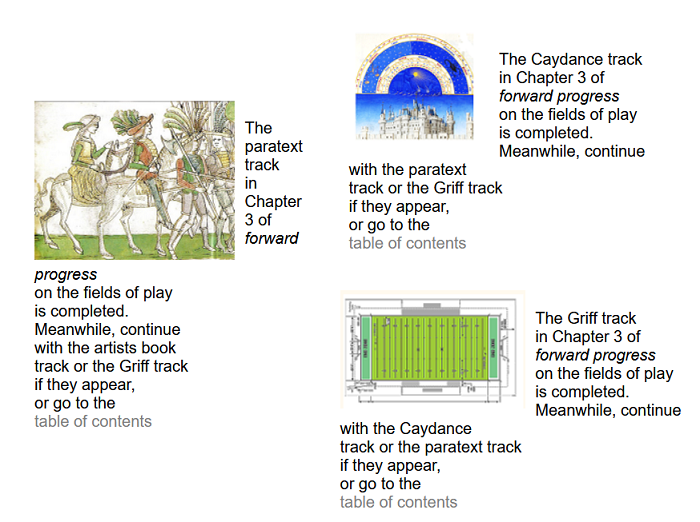
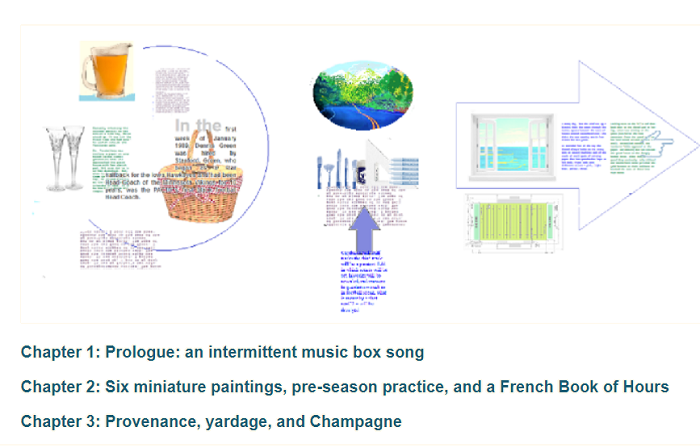
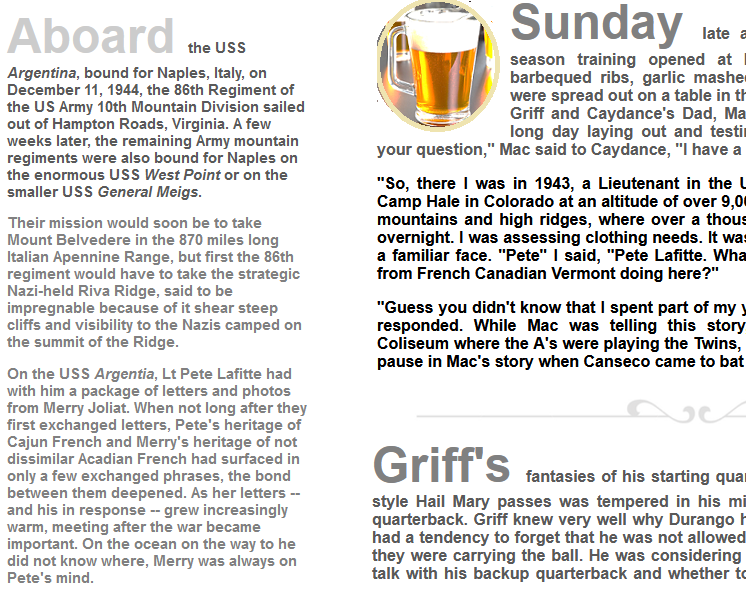
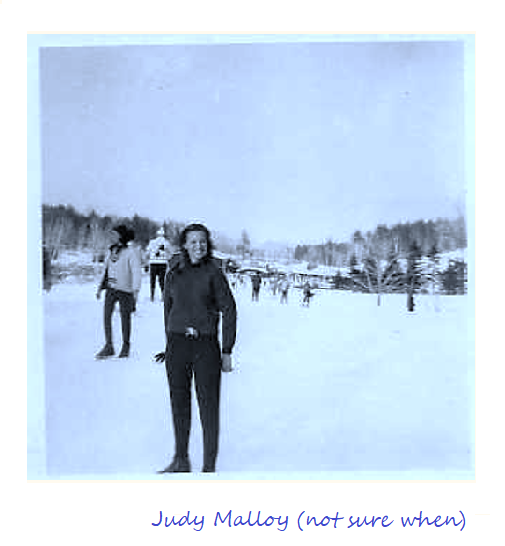 What I remember from the brief, cherished year when I skied for Middlebury under Fred Neuberger is not only the need for extensive off season as well as in season training and the need to focus on mental mapping of the course itself, but also the role of racing technique which is not precisely the same as recreational skiing and even the need to be ready (throughout the different life I chose) for the experience of standing in the starting gate at the top of a steep, icy hill.
What I remember from the brief, cherished year when I skied for Middlebury under Fred Neuberger is not only the need for extensive off season as well as in season training and the need to focus on mental mapping of the course itself, but also the role of racing technique which is not precisely the same as recreational skiing and even the need to be ready (throughout the different life I chose) for the experience of standing in the starting gate at the top of a steep, icy hill.
